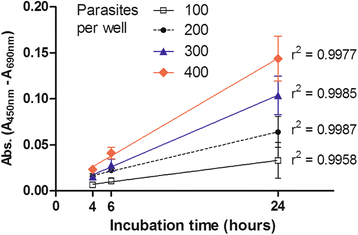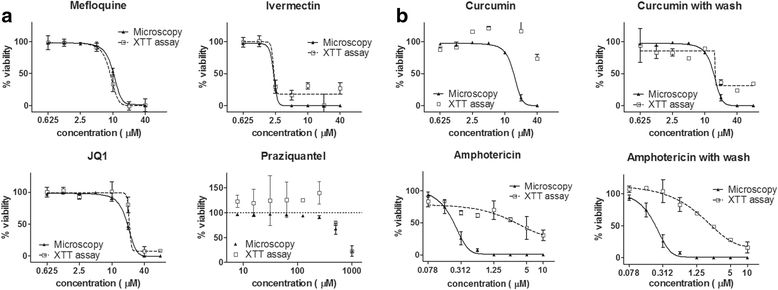A high-throughput colorimetric assay for detection of Schistosoma mansoni viability based on the tetrazolium salt XTT
- PMID: 28637488
- PMCID: PMC5480175
- DOI: 10.1186/s13071-017-2240-3
A high-throughput colorimetric assay for detection of Schistosoma mansoni viability based on the tetrazolium salt XTT
Abstract
Background: Schistosoma mansoni is a trematode parasite that causes schistosomiasis, one of the most prevalent neglected tropical diseases, leading to the loss of 2.6 million disability-adjusted life years. Praziquantel is the only drug available, and new drugs are required. The most common strategy in schistosomiasis drug discovery is the use of the schistosomula larval-stage for a pre-screen in drug sensitivity assays. However, assessing schistosomula viability by microscopy has always been a limitation to the throughput of such assays. Hence, the development of validated, robust high-throughput in vitro assays for Schistosoma with simple readouts is needed. Here, we present a simple and affordable alternative to assess schistosomula viability. The method employed is based on the hydrosoluble tetrazolium salt XTT which has been widely used in other organisms but has never been used to drug screen in schistosomes.
Results: We showed that schistosomula reduce XTT salt to a coloured formazan product and that absorbance levels reflected the viability and parasites number. This XTT viability assay was validated for high throughput screening of compounds in schistosomula, and dose-response curves of compounds could be reproduced.
Conclusions: We conclude that the XTT viability assay could be applied for the screening of large compounds collections in S. mansoni and accelerate the identification of novel antischistosomal compounds.
Keywords: Drug screening; High - throughput screening; Schistosoma mansoni; XTT.
Figures





Similar articles
-
Multi-center screening of the Pathogen Box collection for schistosomiasis drug discovery.Parasit Vectors. 2019 Oct 22;12(1):493. doi: 10.1186/s13071-019-3747-6. Parasit Vectors. 2019. PMID: 31640761 Free PMC article.
-
Discovery by organism based high-throughput screening of new multi-stage compounds affecting Schistosoma mansoni viability, egg formation and production.PLoS Negl Trop Dis. 2017 Oct 6;11(10):e0005994. doi: 10.1371/journal.pntd.0005994. eCollection 2017 Oct. PLoS Negl Trop Dis. 2017. PMID: 28985236 Free PMC article.
-
Fluorescence/luminescence-based markers for the assessment of Schistosoma mansoni schistosomula drug assays.Parasit Vectors. 2015 Dec 8;8:624. doi: 10.1186/s13071-015-1233-3. Parasit Vectors. 2015. PMID: 26644133 Free PMC article.
-
Epigenetic modulation, stress and plasticity in susceptibility of the snail host, Biomphalaria glabrata, to Schistosoma mansoni infection.Int J Parasitol. 2016 Jun;46(7):389-94. doi: 10.1016/j.ijpara.2016.03.003. Epub 2016 Apr 4. Int J Parasitol. 2016. PMID: 27056272 Review.
-
Mechanically produced schistosomula as a higher-throughput tools for phenotypic pre-screening in drug sensitivity assays: current research and future trends.Biomark Res. 2016 Nov 22;4:21. doi: 10.1186/s40364-016-0075-2. eCollection 2016. Biomark Res. 2016. PMID: 27895916 Free PMC article. Review.
Cited by
-
A self-purifying microfluidic system for identifying drugs acting against adult schistosomes.R Soc Open Sci. 2022 Nov 30;9(11):220648. doi: 10.1098/rsos.220648. eCollection 2022 Nov. R Soc Open Sci. 2022. PMID: 36465675 Free PMC article.
-
Identification of hit compounds with anti-schistosomal activity on in vitro generated juvenile worms in cell-free medium.PLoS Negl Trop Dis. 2021 May 25;15(5):e0009432. doi: 10.1371/journal.pntd.0009432. eCollection 2021 May. PLoS Negl Trop Dis. 2021. PMID: 34033658 Free PMC article.
-
A phenotypic screen of the Global Health Priority Box identifies an insecticide with anthelmintic activity.Parasit Vectors. 2024 Mar 14;17(1):131. doi: 10.1186/s13071-024-06183-y. Parasit Vectors. 2024. PMID: 38486232 Free PMC article.
-
Combinatorial Treatment with Praziquantel and Curcumin Reduces Clonorchis sinensis Parasite Burden and Clonorchiasis-Associated Pathologies in Rats.Pharmaceutics. 2024 Dec 3;16(12):1550. doi: 10.3390/pharmaceutics16121550. Pharmaceutics. 2024. PMID: 39771529 Free PMC article.
-
Multi-center screening of the Pathogen Box collection for schistosomiasis drug discovery.Parasit Vectors. 2019 Oct 22;12(1):493. doi: 10.1186/s13071-019-3747-6. Parasit Vectors. 2019. PMID: 31640761 Free PMC article.
References
-
- WHO (World Health Organisation) Schistosomiasis: number of people treated worldwide in 2014. Relev épidémiologique Hebd/Sect d’hygiène du Secrétariat la Société des Nations = Wkly Epidemiol Rec/Heal Sect Secr Leag Nations. 2016;91:53–60. - PubMed
MeSH terms
Substances
LinkOut - more resources
Full Text Sources
Other Literature Sources

